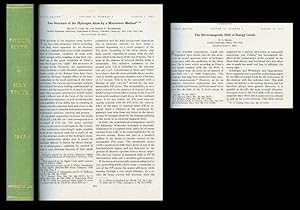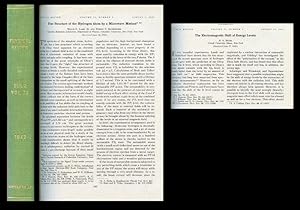lamb willis robert retherford hans (3 résultats)
Filtres de recherche
Type d'article
- Tous les types de produits
- Livres (3)
- Magazines & Périodiques (Aucun autre résultat ne correspond à ces critères)
- Bandes dessinées (Aucun autre résultat ne correspond à ces critères)
- Partitions de musique (Aucun autre résultat ne correspond à ces critères)
- Art, Affiches et Gravures (Aucun autre résultat ne correspond à ces critères)
- Photographies (Aucun autre résultat ne correspond à ces critères)
- Cartes (Aucun autre résultat ne correspond à ces critères)
- Manuscrits & Papiers anciens (Aucun autre résultat ne correspond à ces critères)
Etat En savoir plus
- Neuf (Aucun autre résultat ne correspond à ces critères)
- Comme neuf, Très bon ou Bon (Aucun autre résultat ne correspond à ces critères)
- Assez bon ou satisfaisant (Aucun autre résultat ne correspond à ces critères)
- Moyen ou mauvais (Aucun autre résultat ne correspond à ces critères)
- Conformément à la description (3)
Reliure
- Toutes
- Couverture rigide (Aucun autre résultat ne correspond à ces critères)
- Couverture souple (Aucun autre résultat ne correspond à ces critères)
Particularités
- Ed. originale (3)
- Signé (Aucun autre résultat ne correspond à ces critères)
- Jaquette (Aucun autre résultat ne correspond à ces critères)
- Avec images (3)
- Sans impressions à la demande (3)
Langue (1)
Prix
- Tous les prix
- Moins de EUR 20 (Aucun autre résultat ne correspond à ces critères)
- EUR 20 à EUR 45 (Aucun autre résultat ne correspond à ces critères)
- Plus de EUR 45
Livraison gratuite
- Livraison gratuite à destination de Etats-Unis (Aucun autre résultat ne correspond à ces critères)
Pays
Evaluation du vendeur
-
The Electromagnetic Shift of Energy Levels (Bethe) WITH Fine Structure of the Hydrogen Atom by a Microwave Method, in Physical Review (Lamb) WITH Vol. 72, No. 3, August 1, 1947, pp. 241-243; pp. 339-341
Edité par American Physical Society, Lancaster, 1947
Vendeur : Atticus Rare Books, West Branch, IA, Etats-Unis
Edition originale
EUR 399,76
EUR 8,19 expédition vers Etats-UnisQuantité disponible : 1 disponible(s)
Ajouter au panier1st Edition. FIRST EDITION, FIRST ISSUE of "The Electromagnetic Shift of Energy Levels," in which Bethe, considering the Lamb/Retherford discovery of the shift of the 2S-state of hydrogen upward in energy evidenced in "Fine Structure," took up an idea of Hans Kramer's that if one renormalized the mass of the electron ("taking into account its interaction with its own electromagnetic field, then only those parts of the self-energy which are not contained in the mass of the particle would be observable and amenable to experimentation") (Mehra, The Conceptual Completion, 1039). Full volume with many other papers of significance throughout. "The main idea in Bethe's calculation was to use Kramer's renormalization procedure (although in a quantum, rather than a classical context) for the self-energy of the electron in a nonrelativistic consideration of this problem" (ibid). When done, Bethe had "completed the first non-relativistic computation of the shift of the lines of the hydrogen atom as measured by Lamb and Retherford. Despite the linmitations of the computation, agreement was excellent. [Bethe's] idea was simply to attach infinities to corrections at mass and charge that were actually fixed to a finite value by experiments. In this way, the infinities get absorbed in those constants and yield a finite result in good agreement with experiments. This procedure was named renormalization" (Wikipedia). WITH the FIRST EDITION of the paper in which Lamb announced the fine structure of the hydrogen atom, discovered the discrepancy in electromagnetic theory called the Lamb Shift, and began the revolution that led to Quantum Electrodynamics (QED). QED basically describes how light and matter interact, addressing it as a small difference between energy levels of two orbitals of the hydrogen atom that was unexplained and at odds with prevailing electromagnetic theory, then Dirac's quantum theory of the electron. Lamb explains "electromagnetic attraction and repulsion. in terms of the exchange of photons between charged particles" (Peacock, The Quantum Revolution, 100). The Lamb Shift, then, is a small difference between energy levels of two orbitals of the hydrogen atom that was unexplained and at odds with prevailing electromagnetic theory, then Dirac's quantum theory of the electron. This small difference, caused by the interaction between the electron and the vacuum, became the impetus for the development of QED. QED, sometimes said to be the most accurate physical theory ever written, became the model for quantum field theories that would be developed in the future" (ibid). Able to mathematically describe all phenomena involving electrically charged particles interacting by means of exchange of photons, QED can make extremely accurate predictions. Richard Feynman has called it "the jewel of physics" for this reason. In 1955, Lamb was awarded the Noble Prize along with P. Kusch (whose paper is also included here) "for his discoveries concerning the fine structure of the hydrogen spectrum" (Noble Prize Committee). CONDITION & DETAILS: Full volume. Lancaster: American Physical Society. 4to (10.75 x 8 inches; 268 x 200mm). Entire volume, continuously paginated pp. 1-1304. Lamb's paper: pp. 241-243; Bethe's pp. 339-341. Ex-libris with no markings at the spine whatsoever. Pictorial bookplate on front pastedown; small stamp on blank front flyleaf and title page. Illustration: In-text figures throughout. Exterior: Bound in tan cloth with a gilt-lettered spine; very slight rubbing at the edges. Tightly and solidly bound. Small closed tear at the corner of two pages; interior is bright and clean throughout. Very good condition.
-
Fine Structure of the Hydrogen Atom by a Microwave Method (Lamb) WITH The Electromagnetic Shift of Energy Levels (Bethe) in Physical Review, Vol. 72, August 1, 1947, pp. 241-243; pp. 339-341
Edité par American Physical Society, Lancaster, 1947
Vendeur : Atticus Rare Books, West Branch, IA, Etats-Unis
Edition originale
EUR 399,76
EUR 8,19 expédition vers Etats-UnisQuantité disponible : 1 disponible(s)
Ajouter au panier1st Edition. BOUND FIRST EDITION, FIRST ISSUE of the paper in which Lamb announced the fine structure of the hydrogen atom, discovered the discrepancy in electromagnetic theory called the Lamb Shift, and began the revolution that led to Quantum Electrodynamics (QED). Full volume with many other papers of significance throughout. QED basically describes how light and matter interact, addressing it as a small difference between energy levels of two orbitals of the hydrogen atom that was unexplained and at odds with prevailing electromagnetic theory, then Dirac's quantum theory of the electron. Lamb explains "electromagnetic attraction and repulsion. in terms of the exchange of photons between charged particles" (Peacock, The Quantum Revolution, 100). The Lamb Shift, then, is a small difference between energy levels of two orbitals of the hydrogen atom that was unexplained and at odds with prevailing electromagnetic theory, then Dirac's quantum theory of the electron. This small difference, caused by the interaction between the electron and the vacuum, became the impetus for the development of QED. QED, sometimes said to be the most accurate physical theory ever written, became the model for quantum field theories that would be developed in the future" (ibid). Able to mathematically describe all phenomena involving electrically charged particles interacting by means of exchange of photons, QED can make extremely accurate predictions. Richard Feynman has called it "the jewel of physics" for this reason. In 1955, Lamb was awarded the Noble Prize along with P. Kusch (whose paper is also included here) "for his discoveries concerning the fine structure of the hydrogen spectrum" (Noble Prize Committee). WITH Bethe's "The Electromagnetic Shift of Energy Levels," in which the author, considering the Lamb/Retherford discovery of the shift of the 2S-state of hydrogen upward in energy evidenced in "Fine Structure," took up an idea of Hans Kramer's that if one renormalized the mass of the electron ("taking into account its interaction with its own electromagnetic field, then only those parts of the self-energy which are not contained in the mass of the particle would be observable and amenable to experimentation") (Mehra, The Conceptual Completion, 1039). "The main idea in Bethe's calculation was to use Kramer's renormalization procedure (although in a quantum, rather than a classical context) for the self-energy of the electron in a nonrelativistic consideration of this problem" (ibid). When done, Bethe had "completed the first non-relativistic computation of the shift of the lines of the hydrogen atom as measured by Lamb and Retherford. Despite the linmitations of the computation, agreement was excellent. [Bethe's] idea was simply to attach infinities to corrections at mass and charge that were actually fixed to a finite value by experiments. In this way, the infinities get absorbed in those constants and yield a finite result in good agreement with experiments. This procedure was named renormalization" (Wikipedia). CONDITION & DETAILS: Full volume. Lancaster: American Physical Society. 4to (10.75 x 8 inches; 268 x 200mm). Entire volume, continuously paginated pp. 1-1304. Lamb's paper: pp. 241-243; Bethe's pp. 339-341. Ex-libris with no markings at the spine whatsoever. Pictorial bookplate on front pastedown; small stamp on blank front flyleaf and title page. Illustration: In-text figures throughout. Exterior: Bound in tan cloth with a gilt-lettered spine; very slight rubbing at the edges. Tightly and solidly bound. Small closed tear at the corner of two pages; interior is bright and clean throughout. Very good condition.
-
Fine Structure of the Hydrogen Atom by a Microwave Method, in Physical Review, Vol. 72, No. 3, August 1, 1947, pp. 241-243
Edité par American Physical Society, Lancaster, 1947
Vendeur : Atticus Rare Books, West Branch, IA, Etats-Unis
Edition originale
EUR 710,68
EUR 8,19 expédition vers Etats-UnisQuantité disponible : 1 disponible(s)
Ajouter au panier1st Edition. FIRST EDITION, FIRST ISSUE IN ORIGINAL WRAPS of the paper in which Lamb announced the fine structure of the hydrogen atom, discovered the discrepancy in electromagnetic theory called the Lamb Shift, and began the revolution that led to Quantum Electrodynamics (QED). QED basically describes how light and matter interact, addressing it as a small difference between energy levels of two orbitals of the hydrogen atom that was unexplained and at odds with prevailing electromagnetic theory, then Dirac's quantum theory of the electron. Lamb explains "electromagnetic attraction and repulsion. in terms of the exchange of photons between charged particles" (Peacock, The Quantum Revolution, 100). The Lamb Shift, then, is a small difference between energy levels of two orbitals of the hydrogen atom that was unexplained and at odds with prevailing electromagnetic theory, then Dirac's quantum theory of the electron. This small difference, caused by the interaction between the electron and the vacuum, became the impetus for the development of QED. QED, sometimes said to be the most accurate physical theory ever written, became the model for quantum field theories that would be developed in the future" (ibid). Able to mathematically describe all phenomena involving electrically charged particles interacting by means of exchange of photons, QED can make extremely accurate predictions. Richard Feynman has called it "the jewel of physics" for this reason. In 1955, Lamb was awarded the Noble Prize along with P. Kusch (whose paper is also included here) "for his discoveries concerning the fine structure of the hydrogen spectrum" (Noble Prize Committee). CONDITION & DETAILS: Volume 72, Number 3. Original Wraps 4to (10.5 x 8 inches; 263 x 200mm). Meticulously rebacked at the spine to match the green of the wraps. The wraps are in near fine condition, as is the interior. NOTE THAT THE WRAPS ARE FAR BRIGHTER THAN THEY APPEAR IN THE PICTURE; IT IS JUST A DARK IMAGE FOR SOME REASON.




